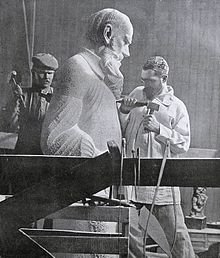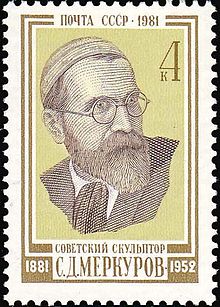Sergei Dmitrievich Merkurov


Sergei Dmitrievich Merkurow ( Russian Сергей Дмитриевич Меркуров ; born October 26, jul. / 7. November 1881 greg. In Alexandropol , † 8. June 1952 in Moscow ) was a Greek - Russian sculptor .
Life
Merkurow, son of a Greek entrepreneur and cousin of Georges I. Gurdjieff , attended secondary school in Tbilisi with graduation in 1901 and then studied in Kiev at the Kiev Polytechnic Institute , which, however, soon excluded him due to political unrest. In autumn 1902 he continued his studies in Switzerland at the Philosophical Faculty of the University of Zurich . There he met Lenin during political discussions . Merkurow became a student of the Swiss sculptor Adolf Meyer. Following Meyer's advice, Merkurow went to Munich to see Wilhelm von Rümann at the Munich Art Academy , where he studied until 1905. Then he lived and worked in Paris until 1907 , where he worked as a sculptor under the influence of the work of Auguste Rodin and Constantin Meunier . In 1907 Merkurov returned to Russia to make a death mask for Catholicos Mkrtitsch Chrimjan for the Armenian Apostolic Church . Merkurov initially lived in Tbilisi and Yalta . In the autumn of 1910 he came to Moscow. Immediately in November he was invited to make a death mask for Tolstoy . Later he created death masks in particular by Howhannes Tumanjan , Lenin, Nadeschda Krupskaja , Maxim Gorki and Vladimir Mayakovsky . 1911–1913 he created the sculpture Der Gedanke , which was placed on his grave in the Novodevichy Cemetery in 1956 . After the October Revolution , Merkurov, as director of the Pushkin Museum, saved the marble statue of Catherine II , made by Alexander Opekuschin on behalf of the entrepreneur and Moscow mayor Nikolai Alexejew and erected in front of the Moscow city duma in 1896, from destruction by bringing it to Armenia and in 2003 in the palace of Tsaritsyno Park was erected.
After the October Revolution, on April 12, 1918, the Council of People's Commissars decided that monuments of historical people should be placed in the cities of Russia, and on July 30, a corresponding list appeared. In Merkurov's studio there were two granite statues of people on this list, namely a Dostoyevsky that Merkurov had made in 1914 on behalf of the millionaire Sharov (with Alexander Wertinsky as a model, after Merkurov had already made around 20 Dostoyevsky busts in 1905 ), and a Tolstoy by 1912. Merkurov offered his two statues to the Moscow City Soviet and a special commission headed by Anatoly Lunacharsky accepted them. In the 1920s, Merkurov became a member of a Masonic lodge . Merkurov created the Dzerzhinsky monument in Stalingrad (1936), the Karl Marx monument in Simbirsk (1921), the Shahumyan monument in Yerevan (1931) and the Kliment Timirjasew monument (1922–1923 with the architect Dmitri Osipov ) in Moscow. 1924–1946 the skin relief for the 26 commissioners of Baku was inaugurated in 1958.
As one of the first monumental sculptors, Merkurov received regular government contracts for Lenin and Stalin statues . He became the chairman of the All-Russian Commission on Lenin Monuments. The largest statue of Lenin (49 m with base), erected in Yerevan in 1940 and removed in 1991, the Lenin monument in Dubna (statue 22 m, base 15 m) erected in 1937 on one side of the Moscow-Volga Canal and the simultaneous Stalin monument came from him the other side, the Stalin statue of which was removed from the pedestal in the course of the de-Stalinization , as well as the Stalin monument at the Moscow Exhibition of the Achievements of the National Economy , which fell into disrepair and was dismantled when the exhibition was rebuilt in 1952. Further Lenin statues of Merkurov were erected in Snizhne and Pervouralsk as well as a Stalin statue in Stalino (1939). In 1939 Merkurov replaced the Lenin monument erected by Issaak Mendelewitsch in Ufa in 1924 with his own concrete sculpture . When it fell into disrepair, a granite replacement was decided in 1987 , but not realized due to lack of financial means. In 2011 an exact copy of the Merkurow monument by the Ufa sculptor Chalit Galimullin was erected with funding from private sponsors .
From 1944 to 1950 Merkurov was director of the Pushkin Museum in Moscow .
In 1945 Merkurov became a member of the CPSU . From the mid-1940s, Nikolai Tomsky , Evgeny Wuchetich and other sculptors came to the fore. Merkurov created another Burdenko monument (1949) in Moscow, the Stalin monument (1950) in Yerevan, a Vishnevsky monument in Moscow and a Tsiolkovsky monument in Moscow. During the thaw period , many of the Stalin monuments disappeared. In Moscow only the Stalin monument in the Moscow Sculpture Park and the one in the courtyard of the Tretyakov Gallery remained .
1984 of the grandfather Fyodor Merkurow in was in the house Gyumri opened a Merkurow Museum. In Moscow's Izmailovo Park on the site of the dacha , where Merkurov lived and worked until his death in 1920, a now weathered Merkurov monument was erected.
Honors, prizes
- Order of Lenin (1939)
- Honored Artist of the Armenian SSR (1940)
- Stalin Prize 1st class in 1941 for the Lenin sculpture in the meeting room of the Great Kremlin Palace and the Stalin sculpture at the exhibition of the achievements of the national economy and in 1951 for the Stalin sculpture in Yerevan
- Honored Artist of the RSFSR (1942)
- People's Artist of the USSR (1943)
- Medal "For heroic work in the Great Patriotic War 1941–1945"
- People's Artist of the Armenian SSR (1950)
- Order of the Red Banner of Labor (twice)
Works
Web links
Individual evidence
- ↑ a b c d ХРОНОС: Сергей Дмитриевич Меркулов (accessed March 4, 2018).
- ↑ a b Русская живопись: МЕРКУРОВ Сергей Дмитриевич (accessed March 4, 2018).
- ↑ У смерти симметричное лицо (accessed March 4, 2018).
- ↑ ЦАРЯМ, ГЕРОЯМ, ТВОРЦАМ, УЧЁНЫМ… (accessed on March 3, 2018).
- ↑ Дом-музей С.Д. Меркурова SD Merkurov's house museum (accessed March 4, 2018).
| personal data | |
|---|---|
| SURNAME | Merkurov, Sergei Dmitrievich |
| ALTERNATIVE NAMES | Merkurov, Sergei (full name); Меркуров, Сергей Дмитриевич (Russian) |
| BRIEF DESCRIPTION | Russian sculptor |
| DATE OF BIRTH | November 7, 1881 |
| PLACE OF BIRTH | Alexandropol |
| DATE OF DEATH | June 8, 1952 |
| Place of death | Moscow |










